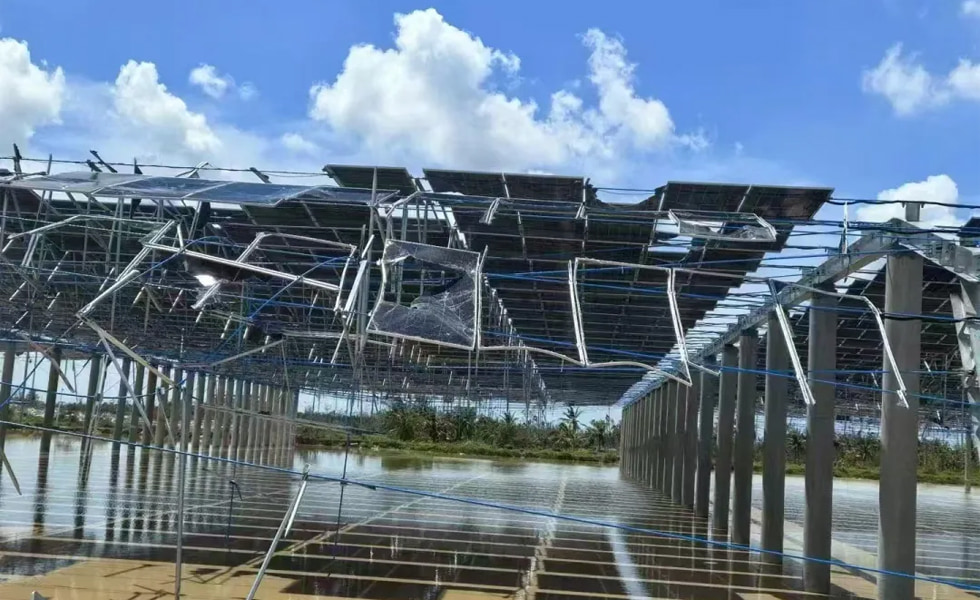
Recently, endless typhoons have put photovoltaic power stations in danger.
According to reports, this year's 11th super typhoon "Makar" landed in Wenchang City, Hainan and Xuwen County, Guangdong at 16:20 and 22:20 on September 6. This is considered to be the strongest autumn typhoon to land in mainland China since the founding of the People's Republic of my country.
According to data, the super typhoon "Mangosteen" in 2018 released energy equivalent to 2,600 Hiroshima atomic bombs in one hour, with the most concentrated part in the "eyewall". This time "Makar" is one level higher than it.
In the face of such a destructive super typhoon, in addition to infrastructure such as trees, electric poles, and guardrails, photovoltaic power stations in typhoon areas have also suffered serious losses.
What preventive measures should photovoltaic power stations take in strong typhoons?
Before the arrival of strong typhoons, conduct a comprehensive and detailed inspection of the installation of photovoltaic power stations and take preventive measures in a timely manner.
• Strengthen the early design maintenance: including whether the screw fasteners and fasteners are firmly fastened, check whether the middle pressure block and side pressure block of the photovoltaic power station are loose, please tighten them in time.
• For photovoltaic power stations installed with hooks and clamps, check whether the hooks and clamps are firmly installed. For photovoltaic power stations installed on flat roofs, the serial components on the windward side can be tied and fixed with double strands of 2 square millimeters of iron wire. For power stations with smaller fixed piers, sandbags can be used to increase the weight of the power station.
• For photovoltaic power stations without protective brackets, install and tighten windproof pull rods to prevent the photovoltaic brackets from twisting with the wind; ground power stations should compact the anchors on both sides of the array.
• Rooftop solar power stations should be inspected regularly to ensure the quality of the buildings on which the photovoltaic project relies.
Emergency measures before typhoons:
• Load reduction and power outages: According to the early warning information, gradually reduce the output power of the solar energy system and reduce the load on the power grid.
• Power-off operation: When a typhoon is approaching, cut off the power supply of the photovoltaic system to prevent electrical failures and safety accidents.
• Fixing and reinforcement: Reinforce the photovoltaic modules, brackets and cables to ensure that the components will not be blown down or damaged by strong winds.
• Protective covers and protective nets: Install temporary protective covers and protective nets to protect solar panels and electrical equipment from damage by wind, sand and debris.
• Site cleaning: Clean up the debris around the photovoltaic power station to prevent these objects from damaging the photovoltaic system in strong winds.
• Check the drainage system: Ensure that the drainage system is unobstructed to prevent heavy rain and water accumulation from affecting the photovoltaic power station.
• Purchase photovoltaic insurance: When the corresponding measures are fully prepared, force majeure factors still need to be considered. For example, the super typhoon this time is a natural disaster that many photovoltaic power stations cannot resist. In the face of such a situation, purchasing photovoltaic insurance can further recover losses and minimize the losses of the power station as much as possible.
In addition, what should be done after the typhoon passes? Check the insulation and sealing of each electrical equipment in the photovoltaic power station, and check whether the AC and DC terminals are connected normally. If the ground photovoltaic power station encounters low terrain, high water level, and water soaking in the junction box, the grid-connected inverter should be removed from the site as much as possible or re-placed on high ground.
When inspecting the power station from a height, please pay attention to personal safety during the operation. Electrical inspection should be performed by professionals with electrician qualifications, and do not touch the high-voltage (DC, AC) live parts at will. Do not work outdoors during a typhoon.
